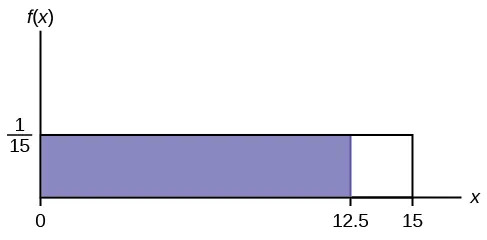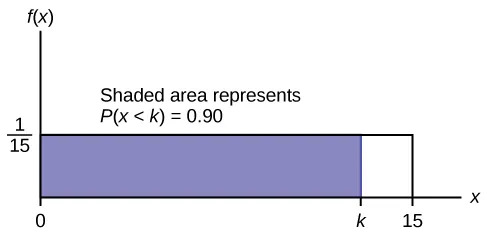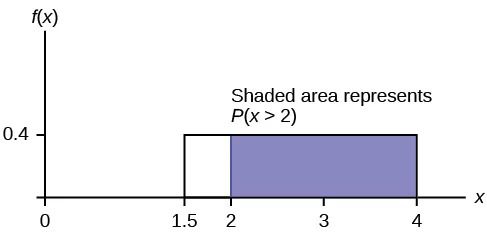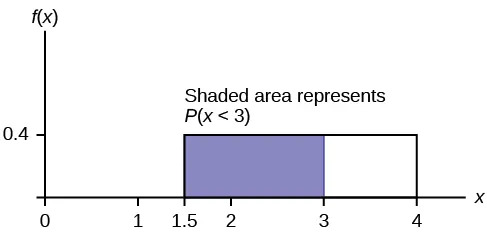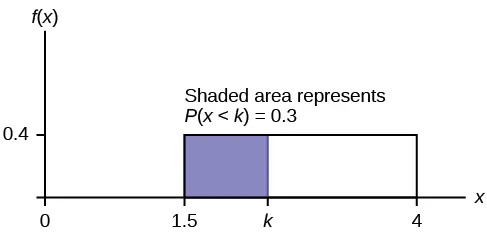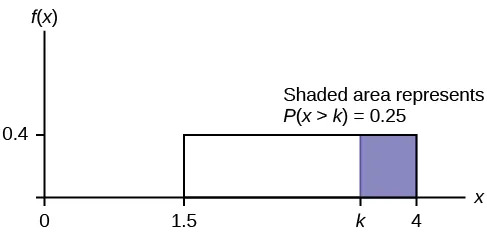Continuous Random Variables
22 The Uniform Distribution
The uniform distribution is a continuous probability distribution and is concerned with events that are equally likely to occur. When working out problems that have a uniform distribution, be careful to note if the data is inclusive or exclusive of endpoints.
Example 5.2
The data in Table 5.1 below are 55 smiling times, in seconds, of an eight-week-old baby.
| 10.4 | 19.6 | 18.8 | 13.9 | 17.8 | 16.8 | 21.6 | 17.9 | 12.5 | 11.1 | 4.9 |
| 12.8 | 14.8 | 22.8 | 20.0 | 15.9 | 16.3 | 13.4 | 17.1 | 14.5 | 19.0 | 22.8 |
| 1.3 | 0.7 | 8.9 | 11.9 | 10.9 | 7.3 | 5.9 | 3.7 | 17.9 | 19.2 | 9.8 |
| 5.8 | 6.9 | 2.6 | 5.8 | 21.7 | 11.8 | 3.4 | 2.1 | 4.5 | 6.3 | 10.7 |
| 8.9 | 9.4 | 9.4 | 7.6 | 10.0 | 3.3 | 6.7 | 7.8 | 11.6 | 13.8 | 18.6 |
The sample mean = 11.49 and the sample standard deviation = 6.23.
We will assume that the smiling times, in seconds, follow a uniform distribution between zero and 23 seconds, inclusive. This means that any smiling time from zero to and including 23 seconds is equally likely. The histogram that could be constructed from the sample is an empirical distribution that closely matches the theoretical uniform distribution.
Let X = length, in seconds, of an eight-week-old baby’s smile.
The notation for the uniform distribution is
X ~ U(a, b) where a = the lowest value of x and b = the highest value of x.
The probability density function is $f(x) = \frac{1}{b-a}$ for a ≤ x ≤ b.
For this example, X ~ U(0, 23) and $f(x) = \frac{1}{23-0}$ or 0 ≤ X ≤ 23.
Formulas for the theoretical mean and standard deviation are
$\mu = \frac{a+b}{2}$ and $\sigma = \sqrt{\frac{(b-a)^2}{12}}$
For this problem, the theoretical mean and standard deviation are
$\mu = \frac{0+23}{2}=11.5$ seconds and $\sigma = \sqrt{\frac{(23-0)^2}{12}}=6.64$ seconds.
Notice that the theoretical mean and standard deviation are close to the sample mean and standard deviation in this example.
Try It 5.2
The data that follow are the number of passengers on 35 different charter fishing boats. The sample mean = 7.9 and the sample standard deviation = 4.33. The data follow a uniform distribution where all values between and including zero and 14 are equally likely. State the values of a and b. Write the distribution in proper notation, and calculate the theoretical mean and standard deviation.
| 1 | 12 | 4 | 10 | 4 | 14 | 11 |
| 7 | 11 | 4 | 13 | 2 | 4 | 6 |
| 3 | 10 | 0 | 12 | 6 | 9 | 10 |
| 5 | 13 | 4 | 10 | 14 | 12 | 11 |
| 6 | 10 | 11 | 0 | 11 | 13 | 2 |
Example 5.3
- Refer to Example 5.2. What is the probability that a randomly chosen eight-week-old baby smiles between two and 18 seconds?
- Find the 90th percentile for an eight-week-old baby’s smiling time.
- Find the probability that a random eight-week-old baby smiles more than 12 seconds KNOWING that the baby smiles MORE THAN EIGHT SECONDS.
Solution 5.3
- $P(2<x<18)=\text{(base)(height)}=(18-2)\left(\frac{1}{23}\right) = \frac{16}{23}=0.6957$
- Ninety percent of the smiling times fall below the 90th percentile, k, so P(x < k) = 0.90.
$P(x<k) = 0.90$
(base)(height) = 0.90
$(k-0)\left( \frac{1}{23}\right) = 0.90$
$k=(23)(0.90) = 20.7$
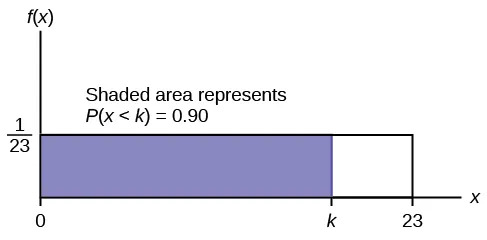
-
This probability question is a conditional. You are asked to find the probability that an eight-week-old baby smiles more than 12 seconds when you already know the baby has smiled for more than eight seconds.
Find P(x > 12|x > 8) There are two ways to do the problem. For the first way, use the fact that this is a conditional and changes the sample space. The graph illustrates the new sample space. You already know the baby smiled more than eight seconds.
Write a new $f(x)$: $f(x) = \frac{1}{23-8}=\frac1{15}$ for $8<x<23$.
$P(x>12 | x>8) = (23-12)\left( \frac1{15} \right) = \frac{11}{15}$
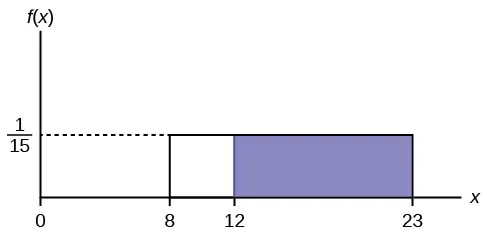
For the second way, use the conditional formula from Probability Topics with the original distribution X ~ U (0, 23):
$P(A|B) = \frac{P(A \text{ and } B)}{P(B)}$
For this problem, $A$ is $(x>12)$ and $B$ is $(x>8)$.So, $P(x>12 | x>8) = \frac{(x>12 \text{ and } x>8)}{P(x>8)} = \frac{P(x>12)}{P(x>8)} = \frac{11/23}{15/23} = \frac{11}{15}$
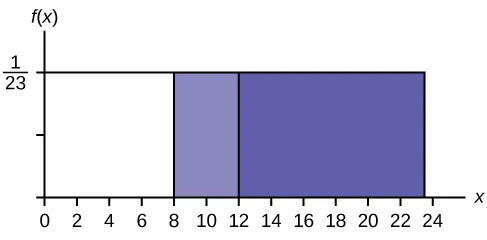
Try It 5.3
A distribution is given as X ~ U (0, 20). What is P(2 < x < 18)? Find the 90th percentile.
Example 5.4
The amount of time, in minutes, that a person must wait for a bus is uniformly distributed between zero and 15 minutes, inclusive.
- What is the probability that a person waits fewer than 12.5 minutes?
- On the average, how long must a person wait? Find the mean, μ, and the standard deviation, σ.
- Ninety percent of the time, the time a person must wait falls below what value?
This asks for the 90th percentile.
Try It 5.4
The total duration of baseball games in the major league in the 2011 season is uniformly distributed between 447 hours and 521 hours inclusive.
- Find a and b and describe what they represent.
- Write the distribution.
- Find the mean and the standard deviation.
- What is the probability that the duration of games for a team for the 2011 season is between 480 and 500 hours?
- What is the 65th percentile for the duration of games for a team for the 2011 season?
Example 5.5
Suppose the time it takes a nine-year old to eat a donut is between 0.5 and 4 minutes, inclusive. Let X = the time, in minutes, it takes a nine-year old child to eat a donut. Then X ~ U (0.5, 4).
- The probability that a randomly selected nine-year old child eats a donut in at least two minutes is _______.
- Find the probability that a different nine-year old child eats a donut in more than two minutes given that the child has already been eating the donut for more than 1.5 minutes.The second question has a conditional probability. You are asked to find the probability that a nine-year old child eats a donut in more than two minutes given that the child has already been eating the donut for more than 1.5 minutes. Solve the problem two different ways (see Example 5.3). You must reduce the sample space. First way: Since you know the child has already been eating the donut for more than 1.5 minutes, you are no longer starting at a = 0.5 minutes. Your starting point is 1.5 minutes.Write a new f(x):
$f(x)=\frac{1}{4-1.5} = \frac{1}{2.5}= \frac{1}{2.5}\cdot\frac{2}{2}=\frac{2}{5}$ for $1.5\leq x \leq 4$Find P(x > 2|x > 1.5). Draw a graph.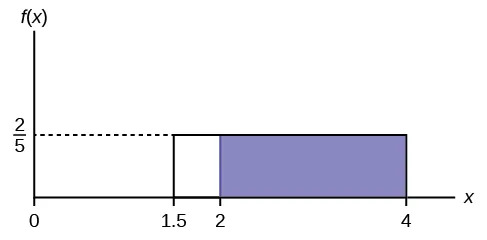
Figure 5.17
P(x > 2|x > 1.5) = (base)(new height) =??
Second way: Draw the original graph for X ~ U (0.5, 4). Use the conditional formula
$P(x>2|x>1.5) = \text{(base)(height)} (4-2)\left(\frac{2}{5} \right) =$ ??
Solution 5.5
- 0.5714
- $\frac{4}{5}$
The probability that a nine-year old child eats a donut in more than two minutes given that the child has already been eating the donut for more than 1.5 minutes is $\frac{4}{5}$
Try It 5.5
Suppose the time it takes a student to finish a quiz is uniformly distributed between six and 15 minutes, inclusive. Let X = the time, in minutes, it takes a student to finish a quiz. Then X ~ U (6, 15).
Find the probability that a randomly selected student needs at least eight minutes to complete the quiz. Then find the probability that a different student needs at least eight minutes to finish the quiz given that she has already taken more than seven minutes.
Example 5.6
Ace Heating and Air Conditioning Service finds that the amount of time a repairman needs to fix a furnace is uniformly distributed between 1.5 and four hours. Let x = the time needed to fix a furnace. Then x ~ U (1.5, 4).
- Find the probability that a randomly selected furnace repair requires more than two hours.
- Find the probability that a randomly selected furnace repair requires less than three hours.
- Find the 30th percentile of furnace repair times.
- The longest 25% of furnace repair times take at least how long? (In other words: find the minimum time for the longest 25% of repair times.) What percentile does this represent?
- Find the mean and standard deviation
Try It 5.6
The amount of time a service technician needs to change the oil in a car is uniformly distributed between 11 and 21 minutes. Let X = the time needed to change the oil on a car.
- Write the random variable X in words. X = __________________.
- Write the distribution.
- Graph the distribution.
- Find P (x > 19).
- Find the 50th percentile.
